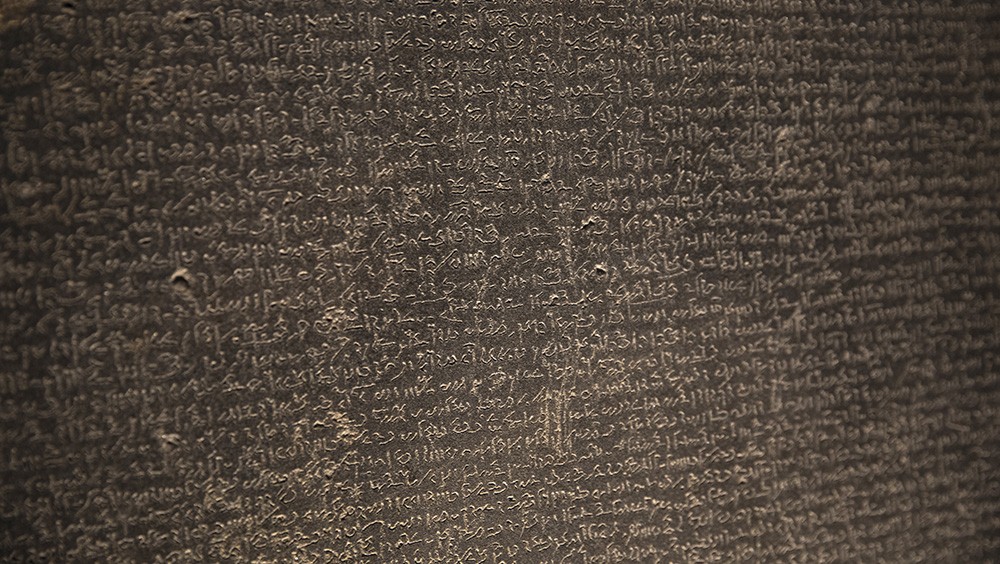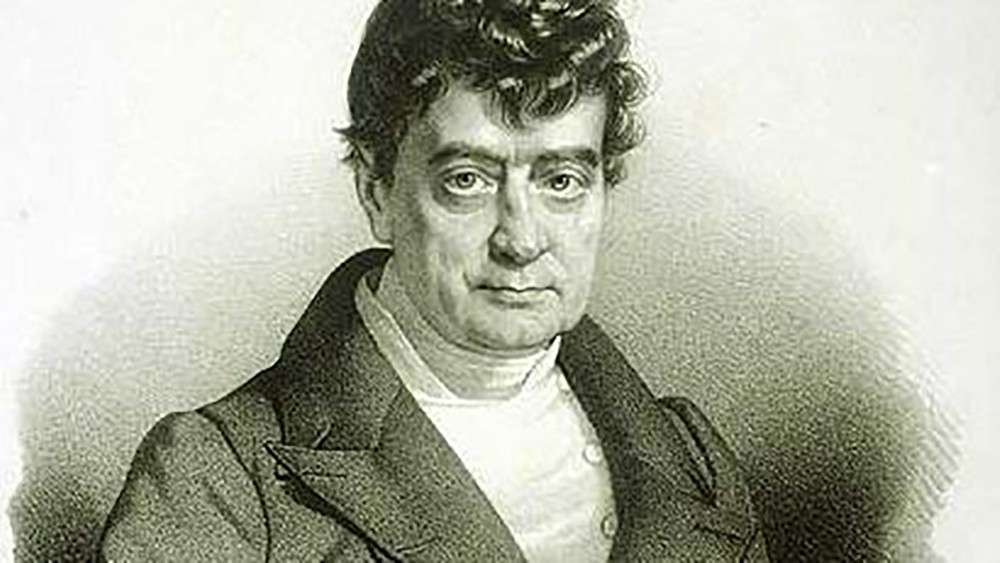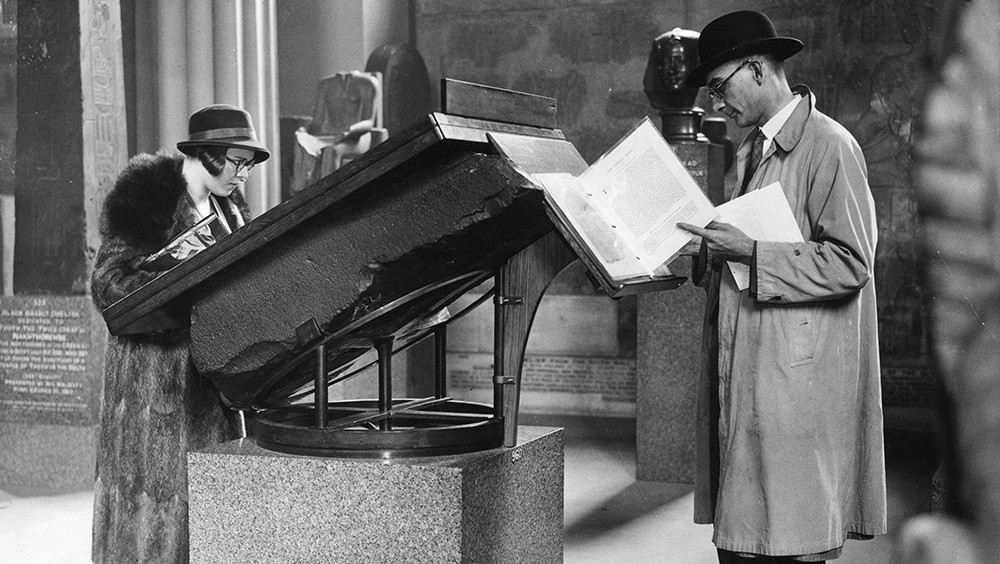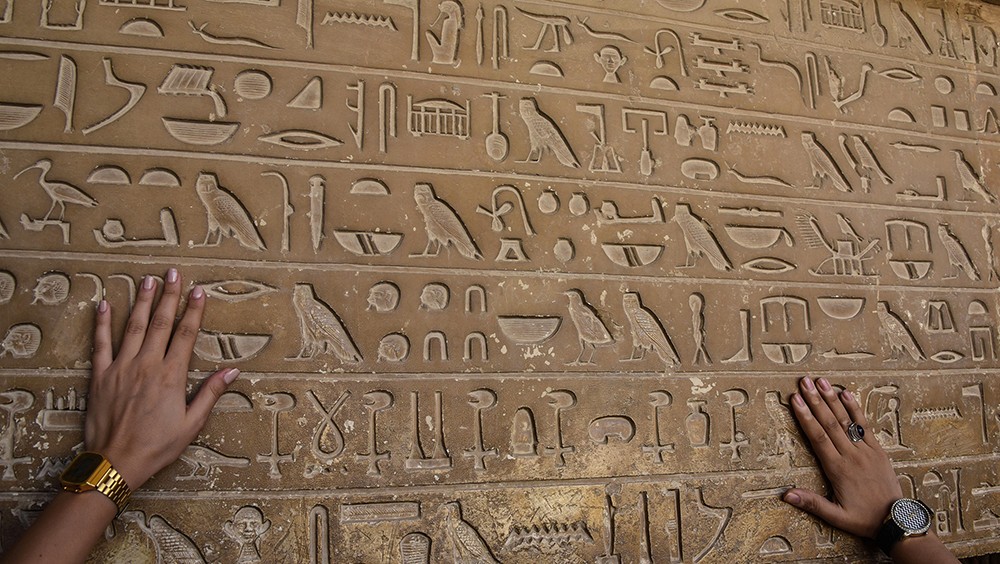Unlocking the secrets of ancient Egypt’s hieroglyphs involved a complex journey through history, linguistics, and collaborative scholarship. At LEARNS.EDU.VN, we aim to clarify this fascinating process and explore the key figures and discoveries that led to our current understanding of these ancient symbols. This article dives deep into the methods and milestones that paved the way for translating hieroglyphics.
1. What Were the Initial Misconceptions About Hieroglyphs?
Early Greek and Roman authors believed hieroglyphs, meaning “sacred writings,” were purely symbolic and lacked phonetic elements, viewing them as divine gifts representing concepts rather than sounds. They dismissed any phonetic component in the hieroglyphs, and claimed that they were conceptual or symbolic signs. Thus, a hieroglyphic pictogram of a hawk was said to represent the concept of swiftness, a pictogram of a crocodile to symbolise all that was evil. This understanding persisted through the Renaissance, hindering decipherment efforts for centuries.
2. Who Proposed the First Scientific Approach to Understanding Hieroglyphs?
In 1740, William Warburton, an English clergyman and future bishop of Gloucester, suggested that writing might have originated from pictorial forms rather than divine sources, marking the first scientific step in deciphering hieroglyphs.
3. What Was Abbé Barthélemy’s Contribution to Hieroglyphic Studies?
In 1762, Abbé Barthélemy correctly hypothesized that hieroglyphic cartouches might contain the names of kings or gods, though his conclusion was based on flawed assumptions. Ironically, his hypothesis was based on two false observations, one being that the hieroglyphs enclosed in cartouches differed from all other hieroglyphs.
4. What Was the Significance of Georg Zoëga’s Conjecture?
Near the end of the 18th century, Danish scholar Georg Zoëga proposed that some hieroglyphs might be notae phoneticae, phonetic signs representing sounds in the Egyptian language, a crucial step towards recognizing the phonetic dimension of hieroglyphs.
5. How Did Napoleon’s Invasion of Egypt Impact Hieroglyphic Research?
Napoleon Bonaparte’s 1798 invasion of Egypt was pivotal. The accompanying scholars and scientists, known as ‘savants,’ discovered the Rosetta Stone, providing a critical key to deciphering hieroglyphs. The presence of the Rosetta Stone helped experts to view the same text in three scripts: Hieroglyphic, Demotic and Greek.
6. What Was Unique About the Rosetta Stone?
The Rosetta Stone featured inscriptions in three scripts: hieroglyphic, demotic, and Greek. The Greek inscription could be translated, offering a baseline for understanding the other two scripts.
The Rosetta Stone in close up, a pivotal artifact for understanding hieroglyphs.
7. How Did Scholars Initially Approach Translating the Rosetta Stone?
Initially, scholars focused on the demotic section of the Rosetta Stone, which was more complete than the hieroglyphic section. They attempted to identify names like Ptolemy by locating repeated groups of demotic symbols in similar positions to the name’s occurrences in the Greek inscription.
8. What Were Silvestre de Sacy and Johann Åkerblad’s Contributions?
In 1802, Silvestre de Sacy and Johann Åkerblad independently searched for names, particularly Ptolemy, within the demotic text. They identified repeated symbol groups corresponding to Ptolemy’s occurrences in the Greek text, hypothesizing that demotic writing was alphabetic like Greek.
Silvestre de Sacy, a key figure in early Rosetta Stone translation efforts.
9. What Crucial Suggestion Did de Sacy Make in 1811?
In 1811, de Sacy suggested that Greek names inside hieroglyphic cartouches, such as those of rulers like Ptolemy and Alexander, might be written alphabetically, mirroring their demotic representation.
10. How Did Thomas Young Advance the Understanding of Hieroglyphs?
In 1815, Thomas Young matched the letters in the Greek spelling of Ptolemy (‘Ptolmes’) with hieroglyphs in the corresponding cartouche, creating a tentative hieroglyphic alphabet. He also demonstrated that demotic signs were derived from hieroglyphic signs, challenging earlier assumptions.
Tourists inspecting the Rosetta Stone detail at the British Museum, showcasing the ongoing interest in deciphering ancient scripts.
11. What Was Young’s Key Insight About Demotic Script?
Young correctly concluded that demotic script was neither purely symbolic nor alphabetic but a mixture of both, consisting of “imitations of the hieroglyphics… mixed with letters of the alphabet.”
12. How Did Jean-François Champollion Build on Previous Discoveries?
Jean-François Champollion recognized that hieroglyphic script, not just the cartouches, might be a mixed script like demotic, combining phonetic and non-phonetic signs.
Jean-François Champollion, whose breakthrough understanding unlocked the secrets of hieroglyphs.
13. What Was the Significance of the Cleopatra Cartouche?
The discovery of the Cleopatra cartouche in 1822 provided Champollion with a nearly complete hieroglyphic alphabet, enabling him to translate the names of numerous rulers, including Alexander and Ramesses.
14. What Was Champollion’s Revolutionary Understanding of Hieroglyphic Writing?
In 1824, Champollion declared that hieroglyphic writing was a complex system that was “at once figurative, symbolic, and phonetic in one and the same text… and, I might add, in one and the same word.” This understanding revolutionized the field of Egyptology.
15. How Did Deciphering Hieroglyphs Impact Our Knowledge of Ancient Civilizations?
Thanks to the ability to translate hieroglyphs, scholars could now uncover the secrets of ancient civilizations, including their history, culture, and religious beliefs, as exemplified by the deciphering of Tutankhamun’s cartouche.
16. Key Milestones in Deciphering Hieroglyphs
| Milestone | Description |
|---|---|
| Early Misconceptions | Initial Greek and Roman beliefs that hieroglyphs were purely symbolic. |
| Warburton’s Proposal (1740) | Suggestion that writing originated from pictorial forms. |
| Barthélemy’s Hypothesis (1762) | Cartouches might contain names of kings or gods. |
| Zoëga’s Conjecture | Some hieroglyphs might be phonetic signs. |
| Discovery of the Rosetta Stone (1799) | Provided parallel inscriptions in hieroglyphic, demotic, and Greek. |
| de Sacy & Åkerblad’s Work (1802) | Identification of names in the demotic text. |
| de Sacy’s Suggestion (1811) | Greek names in hieroglyphic cartouches might be written alphabetically. |
| Young’s Contributions (1815) | Matching letters to hieroglyphs and demonstrating demotic signs derived from hieroglyphs. |
| Champollion’s Breakthrough (1822-1824) | Recognition of hieroglyphic script as a mixed system of figurative, symbolic, and phonetic signs. |




17. The Role of Coptic Language
Spoken Coptic was descended from the language of ancient Egypt, providing approximate pronunciations for ancient Egyptian words, which proved invaluable in reading hieroglyphs. Written Coptic, however, was alphabetic, like Greek and Latin.
18. Understanding Key Terms: Cartouche
Derived from the French word for ‘cartridge,’ it refers to the oval rings enclosing certain groups of hieroglyphs, typically names and titles. The term was coined by French soldiers in Egypt with Napoleon, as the oval rings resembled their gun cartridges.
19. Understanding Key Terms: Demotic
Demotic script, derived from hieroglyphic script, was used from about 650 BC. As the standard script by the time of the Rosetta Stone, it is a cursive script with joined-up letters, suitable for handwriting, unlike the monumental hieroglyphic.
20. Understanding Key Terms: Pictogram
Pictograms are semantic signs that are pictorial in origin. While they can become unrecognizable over time, many represent simple sounds. In the hieroglyphic ‘alphabet,’ for example, the ‘hand’ pictogram stands for ‘d’.
21. The Hieroglyphic Alphabet and Phonetic Components
Contrary to initial beliefs, hieroglyphs do contain phonetic components. The breakthrough in recognizing these phonetic elements was crucial to deciphering the script. For example, in Tutankhamun’s cartouche, the ‘chick’ pictogram represented the vowel ‘u.’
22. The Interplay of Pictorial, Symbolic, and Phonetic Elements
The translation of hieroglyphs required recognizing the interplay between pictorial, symbolic, and phonetic elements. Some signs were figurative, representing objects or ideas directly. Others were symbolic, conveying broader concepts. Still others were phonetic, representing sounds.
Representative pictograms, initially misunderstood as lacking phonetic components.
23. The Legacy of the Rosetta Stone
The Rosetta Stone remains a symbol of scholarly collaboration and the power of multilingual texts in unlocking ancient knowledge. Its discovery and translation spurred further research and discoveries in Egyptology.
24. Contributions from Various Scholars
| Scholar | Contribution |
|---|---|
| Herodotus | Provided early descriptions of ancient Egypt, though not directly related to hieroglyphic translation. |
| William Warburton | Proposed writing originated from pictorial forms. |
| Abbé Barthélemy | Hypothesized cartouches contained royal names. |
| Georg Zoëga | Suggested some hieroglyphs were phonetic signs. |
| Silvestre de Sacy | Identified names in demotic text. |
| Johann Åkerblad | Independently identified names in demotic text. |
| Thomas Young | Matched letters to hieroglyphs; showed demotic derived from hieroglyphs. |
| Jean-François Champollion | Recognized hieroglyphic script as a mixed system. |
25. The Role of Museums and Collections
Museums like the British Museum, which houses the Rosetta Stone, play a critical role in preserving and studying ancient artifacts. These collections provide invaluable resources for researchers and the public alike.
26. The Ongoing Study of Hieroglyphs
The translation of hieroglyphs is an ongoing process, with new discoveries and interpretations continuing to refine our understanding of ancient Egypt. Researchers at institutions worldwide are dedicated to this work.
27. The Importance of Context in Translation
Understanding the context in which hieroglyphs were used is essential for accurate translation. Factors such as the historical period, the purpose of the inscription, and the intended audience all influence the meaning of the text.
28. Modern Techniques in Hieroglyphic Study
Modern technology, including digital imaging and computer-assisted analysis, aids in the study of hieroglyphs, allowing researchers to examine inscriptions in greater detail and collaborate more effectively.
29. Hieroglyphs in Popular Culture
Hieroglyphs have captured the public imagination and are often featured in books, movies, and other forms of popular culture. While these representations are not always accurate, they contribute to a broader awareness of ancient Egypt and its rich history.
30. Hieroglyphs and Ancient Egyptian Religion
Many hieroglyphic inscriptions are related to ancient Egyptian religion, including funerary texts, temple inscriptions, and depictions of gods and goddesses. Understanding these religious contexts is crucial for interpreting the texts.
31. The Process of Mummification and Hieroglyphs
Herodotus provided important information about the process of mummification in ancient Egypt, and hieroglyphs played a role in funerary rituals and texts associated with mummification.
32. The Influence of Ancient Egypt on Athens and Rome
Ancient Egypt exerted a powerful influence on the world of learning for well over two millennia, beginning with the Greek historian Herodotus. Its celebration in ancient Athens and Rome demonstrates its enduring appeal and impact on Western culture.
33. The Valley of the Kings and Tomb Discoveries
The Valley of the Kings, near modern Luxor, contains numerous ancient Egyptian tombs, including the famous tomb of Tutankhamun. Hieroglyphic inscriptions in these tombs provide valuable insights into royal life and beliefs about the afterlife.
34. The Evolution of Writing Systems
The story of hieroglyphic decipherment highlights the evolution of writing systems from pictorial forms to more abstract and phonetic scripts. This evolution is a key theme in the history of communication.
35. The Role of Epigraphy in Hieroglyphic Studies
Epigraphy, the study of ancient inscriptions, is essential for hieroglyphic research. Epigraphers carefully document and analyze inscriptions, providing valuable data for translation and interpretation.
36. Hieroglyphs and Royal Propaganda
Hieroglyphs were often used in royal inscriptions to promote the power and legitimacy of the pharaohs. These inscriptions provide insights into the political and social structures of ancient Egypt.
37. The Use of Hieroglyphs in Ancient Egyptian Art
Hieroglyphs were often integrated into ancient Egyptian art, appearing on statues, monuments, and other objects. The combination of text and image provides a rich source of information about ancient Egyptian culture.
38. The Preservation of Ancient Egyptian Sites
The preservation of ancient Egyptian sites, including temples, tombs, and monuments, is essential for protecting hieroglyphic inscriptions and ensuring that they remain accessible to researchers and the public.
39. The Rediscovery of Ancient Egypt
Napoleon’s invasion of Egypt in 1798 played a crucial role in rediscovering ancient Egypt and bringing its history and culture to the attention of the world. This rediscovery spurred further research and exploration.
40. How Does LEARNS.EDU.VN Help You Learn More?
At LEARNS.EDU.VN, we are dedicated to providing comprehensive resources for learning about hieroglyphs and ancient Egyptian culture. Our platform offers detailed articles, expert insights, and educational materials designed to help you explore this fascinating topic. Whether you’re a student, a teacher, or simply a curious learner, LEARNS.EDU.VN is your go-to source for accurate and engaging information.
Ready to uncover more secrets of ancient Egypt? Visit learns.edu.vn today to explore our in-depth articles and resources. Contact us at 123 Education Way, Learnville, CA 90210, United States, or via Whatsapp at +1 555-555-1212. Start your journey of discovery now!
FAQ: Understanding Hieroglyphs
-
What are hieroglyphs?
Hieroglyphs are the ancient Egyptian writing system that uses pictorial symbols to represent sounds, words, and ideas. -
Who first deciphered hieroglyphs?
Jean-François Champollion is credited with deciphering hieroglyphs, using the Rosetta Stone as a key reference. -
What is the Rosetta Stone?
The Rosetta Stone is an ancient tablet inscribed with the same text in three scripts: hieroglyphic, demotic, and Greek. -
Why was the Rosetta Stone important?
The Rosetta Stone provided a crucial key to understanding hieroglyphs because the Greek inscription was already decipherable. -
How did the Coptic language help in deciphering hieroglyphs?
Coptic, descended from ancient Egyptian, provided approximate pronunciations for hieroglyphic words. -
What is a cartouche?
A cartouche is an oval ring enclosing hieroglyphs, typically representing the names of rulers. -
What is demotic script?
Demotic script is a cursive form of ancient Egyptian writing, derived from hieroglyphs and used from about 650 BC. -
Are hieroglyphs purely symbolic?
No, hieroglyphs are a mixed system that includes figurative, symbolic, and phonetic elements. -
What role did Thomas Young play in deciphering hieroglyphs?
Thomas Young matched letters to hieroglyphs and showed that demotic script was derived from hieroglyphs. -
Where can I see the Rosetta Stone today?
The Rosetta Stone is currently housed in the British Museum in London.

